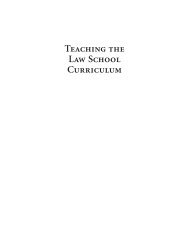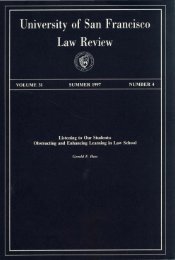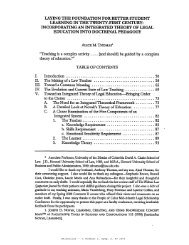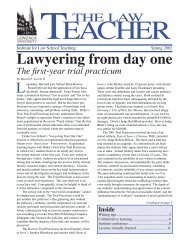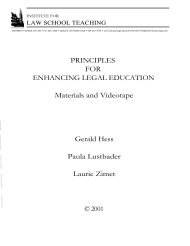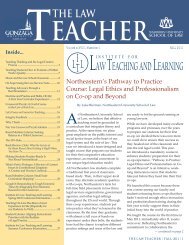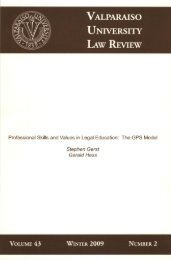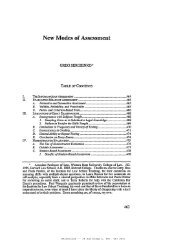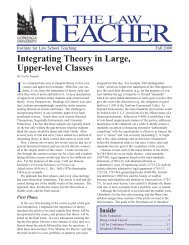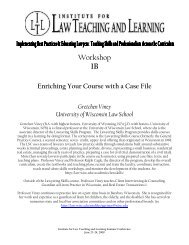The Law Teacher - Institute for Law Teaching and Learning
The Law Teacher - Institute for Law Teaching and Learning
The Law Teacher - Institute for Law Teaching and Learning
You also want an ePaper? Increase the reach of your titles
YUMPU automatically turns print PDFs into web optimized ePapers that Google loves.
epeat Per<strong>for</strong>mances<br />
— continued from page 6<br />
during our next supervision session.<br />
when he did so, the student’s<br />
per<strong>for</strong>mance was markedly improved;<br />
he beamed with confidence afterwards.<br />
I cannot be certain, but I do not think<br />
the student improved merely because he<br />
was more relaxed per<strong>for</strong>ming <strong>for</strong> me in<br />
a law school meeting room than he was<br />
per<strong>for</strong>ming <strong>for</strong> the judge in an agency<br />
courtroom. Nor do I think he improved<br />
merely because he had the opportunity<br />
to learn from repetition.<br />
rather, from our discussions, I think<br />
he improved so significantly because<br />
he received the chance to do the exact<br />
same thing again after he had already<br />
completed the “real” per<strong>for</strong>mance—that<br />
is, after the hearing itself. In his followup<br />
closing argument, the student had<br />
drawn on his experience in the crucible<br />
of the hearing, much more so than on<br />
the practice sessions be<strong>for</strong>e the hearing,<br />
to shape his underst<strong>and</strong>ing of closing<br />
argument skills.<br />
This is a step be<strong>for</strong>e transfer. <strong>and</strong><br />
despite the fact that I stumbled upon<br />
it, it may be a useful tool to consider<br />
adding to our teaching toolbox. For<br />
clinics in particular, how many times do<br />
we ask students to per<strong>for</strong>m anew parts<br />
of the case event after the real event is<br />
over? at least <strong>for</strong> this student, it proved<br />
an immensely valuable experience to<br />
undertake be<strong>for</strong>e he was asked to engage<br />
in learning by transfer. It reaffirmed<br />
key lessons, revealed new insights, <strong>and</strong><br />
solidified confidence. Indeed, it made<br />
the subsequent learning by transfer even<br />
more successful. Perhaps we ought to<br />
consider “repeat per<strong>for</strong>mances” more<br />
often.<br />
____________<br />
Daniel L. Nagin is associate professor of<br />
law <strong>and</strong> the director of the Family Resource<br />
Clinic at the University of Virginia School of<br />
<strong>Law</strong>. He can be reached at dnagin@virginia.<br />
edu.<br />
<strong>The</strong> Internship Model to Teach Legal research <strong>and</strong><br />
writing<br />
— continued from page 5<br />
rights that were not optimally aligned.<br />
In this internship model, I expected little.<br />
If the student volunteer did not produce<br />
work—<strong>and</strong> most of them did not—they<br />
expected nothing in return. all these<br />
students already knew me as a <strong>for</strong>mer<br />
instructor, so we began with familiarity<br />
of each other, which is rarely the case in<br />
competitive hiring.<br />
<strong>The</strong> compensation I offered was wholly<br />
intrinsic. a title (such as “research<br />
assistant with Professor X”), association<br />
with a professor (several asked <strong>for</strong><br />
letters of reference), research <strong>and</strong> writing<br />
skill development, <strong>and</strong> co-authorship<br />
of a published article can be powerful<br />
inducements. This opportunity is not<br />
a course or experience <strong>for</strong> which the<br />
student receives credit on the transcript,<br />
or money in the bank, but it is of<br />
inestimable value in burnishing one’s<br />
curriculum vitae <strong>and</strong> distinguishing the<br />
student from one’s peers.<br />
This small experience yielded a normal<br />
curve of outcomes. If my experience<br />
is predictive of anything, professors<br />
adopting this internship model might<br />
expect something close to half the<br />
students who initially step <strong>for</strong>ward to<br />
not ultimately commit to assist. <strong>The</strong><br />
key will be to identify these students as<br />
early as possible as non-committers. <strong>The</strong><br />
others will assist <strong>and</strong> work toward their<br />
promise in some way, <strong>and</strong> a few of them<br />
will soar.<br />
In the end, seven students out of 30 went<br />
the distance <strong>for</strong> themselves <strong>and</strong> <strong>for</strong> legal<br />
research. Five articles were produced<br />
<strong>and</strong> co-authored, <strong>and</strong> several more are in<br />
progress.<br />
____________<br />
Peter Bowal is professor of law at Haskayne<br />
School of Business at the University of<br />
Calgary. Contact him at peter.bowal@<br />
haskayne.ucalgary.ca.<br />
TeachINg aNd learNINg NuggeT<br />
Consider giving your students<br />
a say in the construction of your<br />
syllabus. Students who have<br />
contributed to decisions regarding<br />
coverage <strong>and</strong> grading are more<br />
likely to invest themselves in<br />
the course.<br />
<strong>The</strong> <strong>Law</strong> <strong>Teacher</strong> | FaLL 2012 | 7




